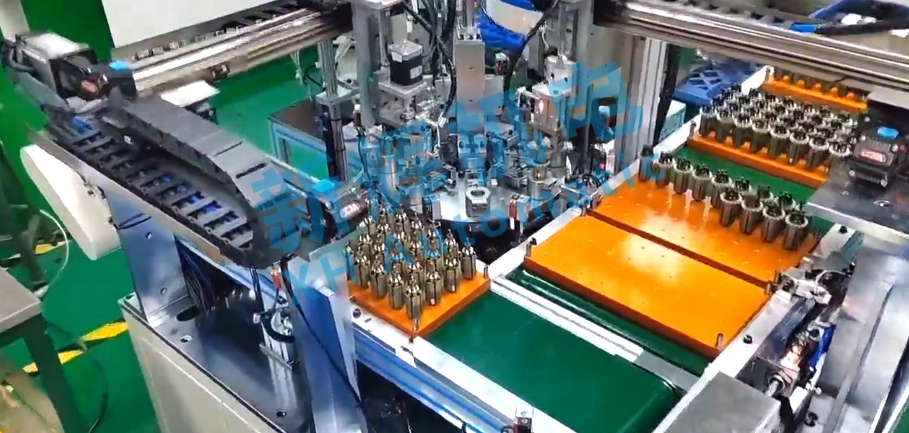What are the common mechanical failures and solutions for motor motor rotor automatic wind blade machine?
1, wind blade mounting mechanism failure
l Failure phenomenon
The wind blade installation position is inaccurate, appearing offset, tilted or not fully installed in place. This may cause the wind blade to be unbalanced during operation, generating vibration and noise, and may even collide with other parts.
The movement of the air blade mounting mechanism is stuck or jammed, making it impossible to install the air blade smoothly. This situation may cause an interruption in the machine's automatic operation process, affecting productivity.

l Cause of Failure
Wear and tear of the mounting tool is one of the common causes. For example, the collet of the air blade mounting fixture wears out after a long period of use, resulting in uneven or insufficient clamping force on the air blade, which affects the mounting accuracy.
Problems in the mechanical transmission part of the mounting mechanism, such as worn transmission gears, loose chains or increased screw pitch error. These problems will lead to a decline in the movement accuracy of the mounting mechanism, which in turn affects the accuracy of the installation position of the wind blade.
The lack of lubrication of the moving parts of the mounting mechanism increases friction, which makes it easy for jamming to occur. In addition, dust, debris and other impurities enter into the interior of the mounting mechanism, which may also lead to blocked movement between parts.
l Solution
Regularly inspect and replace worn mounting tools. For the worn fixture collet, you can use the method of replacing the collet or repairing the collet, such as restoring its clamping accuracy by welding, grinding and other processes.
Check the mechanical transmission part of the mounting mechanism. For worn gears, decide whether to repair or replace them according to the degree of wear; adjust the tension of the chain, repair or replace the damaged chain; check the pitch accuracy of the screw, and if necessary, replace or calibrate the screw.
Do a good job of lubricating the mounting mechanism. Regularly clean the dust and debris on the surface of the moving parts, and then add the right amount of lubricant, such as lubricating oil or grease, to reduce friction. At the same time, set guards around the machine to prevent impurities from entering.
2、Rotor drive failure
l Fault phenomenon
The rotor does not rotate smoothly and there is an obvious sense of blockage. This situation will lead to an increase in the motor load, which may cause the motor to overheat or even damage the motor.
Slippage between the rotor and the transmission parts makes the rotor speed unstable, affecting the installation accuracy of the air blades and the overall operating efficiency of the machine.
l Failure causes
Wear and looseness of the transmission belt or coupling are the common causes of rotor transmission failure. The belt will be aged and elongated after a long time of use, resulting in reduced friction with the pulleys, thus resulting in slippage. Damage to the elastic element of the coupling or loosening of the connecting bolts will also affect the transmission of power.
Poor fit of the rotor journals to the bearings, such as worn journals, damaged bearings or poor lubrication. This can cause the rotor to suffer extra resistance during rotation and rotate poorly.
l Solution
For worn or loose drive belts, replace them or adjust their tension in time. For the coupling, check the damage of the elastic elements, replace the damaged parts and retighten the connecting bolts.
Check the condition of rotor journals and bearings. If the journals are worn, they can be repaired using processes such as chrome plating and spraying; for damaged bearings, replace them in a timely manner and ensure that they are installed correctly and that they are well lubricated. Suitable lubricants, such as high temperature grease, can be used to reduce the friction coefficient of the bearings.
3、Fixture failure
l Failure phenomenon
The fixture is unable to accurately clamp or loosen the rotor, resulting in unstable position of the rotor in the process of installing the wind blade, affecting the quality of installation.
The positioning accuracy of the fixture decreases, resulting in the deviation of the rotor installation position, which affects the matching accuracy of the wind blade and the rotor.
l Failure causes
Wear and tear of the clamping jaws of the fixture is one of the main reasons. Clamping jaws in the long-term clamping and unclamping operation, and the rotor surface frequent contact, easy to wear, resulting in insufficient or uneven clamping force.
The mechanical structure of the fixture is deformed, such as due to external impact or long-term excessive clamping force, making the positioning parts of the fixture deformed, thus affecting its positioning accuracy.
l Solution
Regularly check the wear of the clamping jaws of the fixture, for serious wear of the clamping jaws, should be replaced in a timely manner. You can also carry out surface treatment on the clamping jaws, such as surfacing wear-resistant materials, in order to extend its service life.
Check whether the mechanical structure of the fixture is deformed. If deformation is found, the fixture needs to be repaired or replaced. In the process of operation, to avoid unnecessary impact on the fixture, and at the same time, reasonably adjust the clamping force to avoid excessive wear of the clamping jaws.
※ If you still can't solve the problem by the above ways and means, please contact the technical specialist of Xinhui Electromechanical Equipment Ltd. through the page chat tool to seek help.







